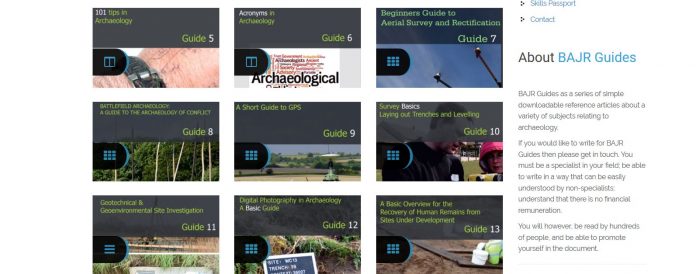To maintain a professional workforce there has to be an ethos of training and skill acquisition. It is true to say that as individuals we can’t be experts in all areas of archaeology, but it is important to have a wide breadth of understanding as this will enable us to work more competently within the discipline.
Although there are many in-depth tomes on most archaeological specialisms, short introductory documents help you start to understand a particular skill, BAJR Guides were begun over decade ago – inviting specialists to write about their subject to a general audience. Like a ten minute tool talk.
These guides are no substitute for more in-depth training courses or specialist seminars; however, understanding the basics provides a head start to any continued learning experience.
BAJR Guides can be divided into 3 main categories:
- Specialist Guides;
- Aspects of commercial employment or legislation;
- Step-by-step procedural guides.
Currently there are 51 BAJR Guides available in pdf format that can be downloaded for free on a range of subjects from aerial survey (which I need to update – given the rise of UAV imaging) to understanding fish remains, obtaining a CSCS card (recently updated) or professional site photography. One popular guide is aimed at individuals carrying out their first excavation and unsure as to what to expect – Dig Survivor. As well as the ever popular and detailed QGIS for Archaeologists
The more detailed documents examine the requirements for carrying out community excavations and survey, and feature templates for reporting and recording as well as dealing with health and safety challenges.
Part of the interest in these guides comes from the open nature and democratisation of the information, and the fact that they are easily accessible to the new starter or community group in the same way that they are available to the professional archaeologist. There are several detailed Documents online as well, ranging from Understanding Employability to Post Excavation Development.
Open to offers
BAJR is always on the lookout for practitioners to write guides. There is a benefit to the writer as well, being read by thousands of people and having their name associated with a particular specialism.
A standard guide will be around 10-30 pages long (though some more detailed documents are allowed), with a BAJR cover, format and style (all copyright retained by the author). The principal is always open and free access and many guides need to be updated periodically as new techniques or new legislation appears. The creation of a BAJR Guide could be seen by the writer as much as by the reader as part of their CPD requirements of CIfA membership.
Currently two more are in production; using Historic Environment Records and Working with Volunteers.
The coming decades will see quality training as the next issue to be tackled by our profession, and the BAJR Guides are helping to make inroads into that area. Along with the Skills Passport and the upcoming BAJR Academy, we are working together to provide the material for all of us to keep learning.
The full range of BAJR Guides can be found here: http://www.bajr.org/BAJRRead/BAJRGuides.asp

